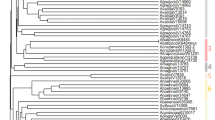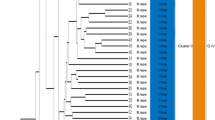Summary
Annual beets in the genus Beta section Beta represent an important genetic resource. Representative accessions of annual beets from a beet germplasm collection were analysed using RAPD to assess the patterns of variation and relationships among them. Using arbitrary primers, markers showing variation across accessions were identified. A dendrogram of similarity was produced using these molecular markers. All the accessions analysed were classified into three major groups corresponding to species or subspecies macrocarpa, adanensis and maritima. Macrocarpa was shown to be the most divergent group in this section. Using RAPD molecular markers, it was possible to ascribe an accession to one of three taxonomic groups and overcome much of the confusion encountered when morphological traits are used for identification. The group of maritima was found to be more polymorphic than either the group of macrocarpa or adanensis at both accession and subspecies levels.
Similar content being viewed by others
References
Abe, J., H. Yoshikawa & C. Tsuda, 1985. Genetic analysis for annuality and self fertility in wild relatives of sugar beet, made by using the pigment gene and some enzyme loci as markers. Proceeding of the sugar beet research association. No. 27. Japan.
AbeJ. & C.Tsuda, 1987. Genetic analysis for isozyme variation in the section Vulgares. Genus Beta. Japan. J. Breed. 37: 253–261.
BarzenE., W.Mechelke, E.Ritter & E.Schulte-Kappert, 1995. An extended map of the sugar beet genome containing RFLP and RAPD loci. Theor Appl Genet. 90: 189–193.
BoundryP., R.Wieber, P.Saumitou-Laprade, K.Pillen, H.VanDijk & C.Jung, 1994. Identification of RFLP markers closely linked to the bolting gene B and their significance for the study of the annual habit in beets (Beta vulgaris L.). Theor. Appl. Genet. 88: 852–858.
Dalke, L. & M. Szota, 1993. Possibility for utilising the male sterility from Beta maritima in sugar beet breeding. Abstracts in A Report on the third international Beta genetic resources workshop and world network conference. Fargo, USA, 4–6 August, 1993. p14.
DevosK.M. & M.D.Gale, 1992. The use of random amplified polymorphic DNA markers in wheat. Theor. Appl. Genet. 84: 567–572.
Ford-LloydB.V., 1986. Intraspecific variation in wild and cultivated beets and its effects upon infraspecific classification. In Infraspecific classification of wild and cultivated plants. B.T.Styles (ed.). Clarendon Press, Oxford, pp331–344.
Gavrielatou, H. (1992). Isozyme and tissue culture variation in short generation beets. MSc thesis, the University of Birmingham. Birmingham, UK.
HenninkS. & ZevenA.C. (1990) The interpretation of Nei and Shannon-Weaver index within population variation indexes. Euphytica 51: 235–240.
HowellE.C., H.J.Newbury, R.L.Swennen, L.A.Withers & B.V.Ford-Lloyd, 1994. The use of RAPD for identifying and classifying Musa germplasm. Genome 37: 328–332.
Lange, W., T.S.M. De Bock & R. K. Lankhorst, 1993. Pre-breeding for nematode resistance in beet. Abstracts in A Report on the third international Beta genetic resources workshop and world network conference. Fargo, USA, 4–6 August 1993. p13.
Letschert, J.P.W., W. Lange, L. Frese & R.G. Van Der Berg, 1993. A taxonomical revision of Beta section Beta. Abstracts in A Report on the third international Beta genetic resources workshop and world network conference. Fargo, USA, 4–6, August 1993. p13.
LevallM.W., K.Bengtsson, N.Nilsson, A.Hjerdin & C.Hallden, 1994. Molecular characterisation of UV-treated beet somaclones using RFLP markers. Physiologia Plantarum 90: 216–220.
Lewellen, R.T., 1993. Pre-breeding sugar beet for virus and Rhizomania resistance. Abstracts in A Report on the third international Beta genetic resources workshop and world Beta network conference. Fargo, USA, 4–6 August 1993. p11.
LorenzM., A.Weihe & T.Borner, 1994. DNA fragments of organellar origin in random amplified polymorphic DNA (RAPD) patterns of sugar beet (Beta vulgaris L.). Theor. Appl. Genet. 88: 775–779.
MargaleE.A.M., R.Delourme & Y.Herve, 1994. Description of genetic diversity within Brassica oleracea using isozymatic and molecular markers. Genetics Selection Evolution 26: S137-S153.
MitaG., M.Dani, P.Casciari, A.Pasquqli, E.Selva, C.Minganti & P.Piccardi, 1991. Assessment of the degree of genetic variation in beet based on RFLP analysis and the taxonomy of Beta. Euphytica 55: 1–6.
NagamineT., J.P.Catty & B.V.Ford-Lloyd, 1989. Phenotypic polymorphism and allele differentiation of isozymes in fodder beet, multigerm sugar beet and monogerm sugar beet. Theor. Appl. Genet. 77: 711–720.
SabirA., H.J.Newbury, G.Todd, J.P.Catty & B.V.Ford-Lloyd, 1992. Determination of genetic stability using isozymes and RFLPs in beets plants regenerated in vitro. Theor. Appl. Genet 84: 113–117.
SalontijinE.M.J., N.N.Sandal, R.Klein-Lankhorst, W.Lange, T.H.DeBock, K. A.Marcker & W.J.Stiekema, 1994. Long-range organisation of a satellite DNA family flanking the beet cyst nematode resistance locus (Hs1) on chromosome-1 of B. patellaris and procumbens. Theor. Appl. Genet. 89: 459–466.
SambrookJ.F. Fritsch & T.Maniatis, 1989. Molecular cloning: a laboratory manual. Cold Spring Harbor Laboratory Press, Cold Spring Harbor, NY.
SendaM., Y.Onodera, T.Kinoshita & T.Mikami, 1995. Mitochondrial gene variation and the relationships in the genus Beta. Theor. Appl. Genet. 90:914–919.
Theurer, J.C., 1993. Pre-breeding to change root architecture. Abstracts in A Report on the third international Beta genetic resources workshop and world Beta network conference. Fargo, USA, 4–6 August 1993. p11.
VirkP.S., B.V.Ford-Lloyd, M.T.Jackson & H.J.Newbury, 1995. Use of RAPD for the study of diversity within plant germplasm collections. Heredity 74: 170–179.
WilliamsJ.G.K., A.R.Kubilek, K.J.Livak, J.A.Rafalski & S.Tingey, 1990. DNA polymorphism amplified by arbitrary primers are useful as genetic markers. Nucleic Acids Res. 18: 6531–6535.
VanGeytJ.P.C., W.Lange, M.Oleo & T.S.M.Debock, 1990. Natural variation within the genus Beta and its possible use for breeding sugar beet. Euphytica 49: 57–76.
Author information
Authors and Affiliations
Rights and permissions
About this article
Cite this article
Shen, Y., Newbury, H.J. & Ford-Lloyd, B.V. The taxonomic characterisation of annual Beta germplasm in a genetic resources collection using RAPD markers. Euphytica 91, 205–212 (1996). https://doi.org/10.1007/BF00021071
Received:
Accepted:
Issue Date:
DOI: https://doi.org/10.1007/BF00021071




